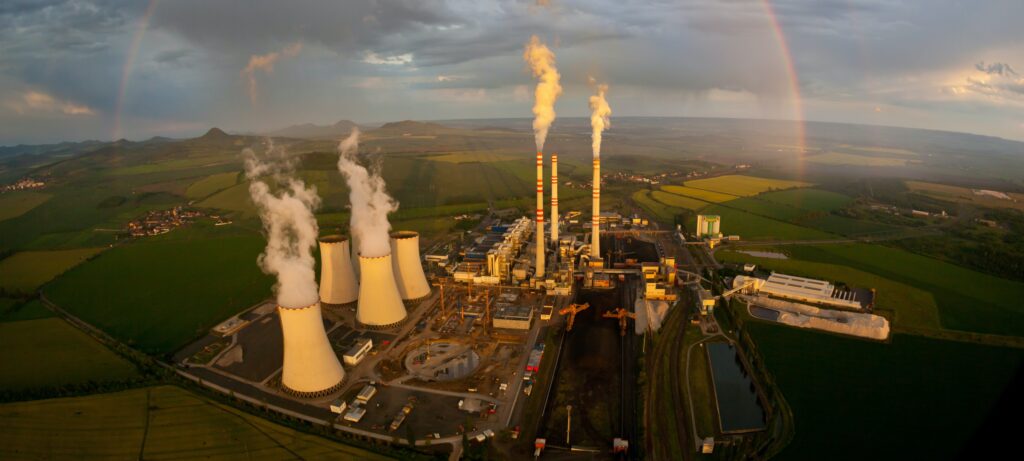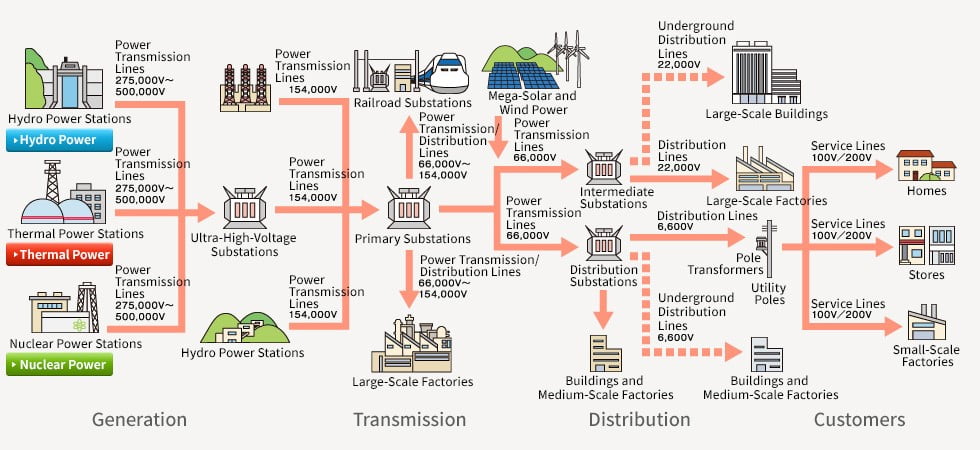We’ll see from sparking innovations in Edison’s era to the current dance of electrons in smart grids, join us on a charged journey through the generations, demystifying the electrifying path from power plants to your very fingertips!
Electricity powers our homes, schools, and businesses, yet the journey it takes to reach us is a fascinating tale of innovation and engineering. In this article, we’ll embark on a journey through the generations of electricity generation, transmission, and distribution, unraveling the technicalities while keeping it accessible to the common man and students.
Phase 1: Power Generation

Generating the Spark:
Electricity begins its journey in power generation plants. Traditionally, coal and hydroelectric power plants were the heroes, but today, solar and wind are taking the spotlight. These sources harness natural elements to generate clean and sustainable energy.
Important Technical Equipment & Elements in Power Generation:
Inside these power plants, turbines spin, converting kinetic energy into electricity. Generators work their magic by transforming mechanical energy into the electrical current we use. It’s a dance of physics and engineering that powers the grid.
Boiler:
Boilers are crucial components in thermal power plants. They convert water into steam using heat generated from the combustion of fossil fuels (coal, natural gas, or oil) or other heat sources. The steam produced is used to drive turbines.
Turbine:
Turbines convert the kinetic energy of steam or other fluids into mechanical energy. As the high-pressure steam flows through the turbine blades, it causes the turbine to rotate. This rotational motion is used to turn a generator and produce electricity.
Generator:
Generators are devices that convert mechanical energy into electrical energy. In power plants, generators are coupled with turbines. As the turbine spins, it drives the generator’s rotor, inducing electrical currents in the generator’s stator, ultimately producing electricity.
Condenser:
Condensers are used to condense the steam coming out of the turbine back into water. This process allows for the efficient recycling of water in the power plant cycle.
Cooling Tower:
Cooling towers help dissipate excess heat from the power plant, especially in thermal power plants. They transfer heat to the atmosphere by evaporating a small portion of the water that circulates through the cooling system.
Transformer:
Transformers are essential for voltage transformation. They step up the voltage for efficient long-distance transmission from the power plant to distribution substations, and step it down again for local distribution.
Control System:
The control system oversees and manages the various processes in the power plant. It monitors temperature, pressure, and other critical parameters to ensure the plant operates safely and efficiently.
Switchgear:
Switchgear is a collection of electrical disconnect switches, fuses, and circuit breakers used to control, protect, and isolate electrical equipment in the power plant. It ensures the safety and reliability of the electrical system.
Fuel Handling System:
In plants using fossil fuels, a fuel handling system is responsible for the storage, handling, and transportation of fuel (coal, oil, or gas) to the combustion chamber or boiler.
Ash Handling System:
In coal-fired power plants, an ash handling system is essential for the collection and disposal of ash generated during the combustion process to prevent environmental pollution.
These are just a few of the primary components involved in power generation. The configuration and specific equipment may vary depending on the type of power plant (thermal, hydroelectric, nuclear, etc.) and the technologies used.

Phase 2: Power Transmission
Highways of Electricity:
Once generated, electricity embarks on a journey through transmission lines, the superhighways of the power grid. These lines can span hundreds of miles, connecting power plants to cities. Transformers play a crucial role in adjusting voltage levels for efficient travel which are the part of power substations at different places.
Important Technical Equipment & Elements in Power Transmission:
Transmission Lines:
High-voltage transmission lines are the primary infrastructure for transporting electricity over long distances. They consist of conductors (often aluminum or copper) supported by towers or poles. The high voltage reduces energy loss during transmission.
Substations:
Substations act as intermediate points between power plants and end-users. They are equipped with transformers that either step up or step-down voltage levels, ensuring efficient energy transfer.

Transformers:
Transformers play a critical role in adjusting voltage levels. Step-up transformers increase voltage for long-distance transmission, while step-down transformers reduce voltage for local distribution.
Switchgear:
Switchgear includes switches, circuit breakers, and other control devices that manage the flow of electricity within the transmission system. They enable operators to control and protect the network.
Capacitor Banks:
Capacitor banks help improve the power factor and efficiency of the transmission system by providing reactive power support. They are used to maintain voltage levels and reduce losses.
Reactive Power Compensation Equipment:
Devices like static VAR compensators (SVCs) and synchronous condensers are used to control reactive power and stabilize voltage levels, enhancing the overall reliability of the transmission network.
High-Voltage Direct Current (HVDC) Converters:
In some cases, HVDC transmission is used for long-distance transmission where AC lines may be less efficient. HVDC converters are employed to convert AC to DC and vice versa.
Transmission Towers:
Transmission towers support the overhead transmission lines. They are strategically designed to carry the weight of conductors and withstand environmental conditions.
Transmission Planning and Control Systems:
Advanced control systems monitor and manage the transmission network in real-time. They provide operators with insights into system performance, enable remote control, and optimize the flow of electricity.
Protection Devices:
Protective relays and devices are installed to detect and respond to abnormal conditions, such as overloads or faults. They help isolate faulty sections to prevent widespread outages.
Power Flow Controllers:
These devices allow for the dynamic control of power flow on the transmission grid. They enhance system flexibility, stability, and reliability.
Energy Storage Systems:
Energy storage, such as batteries, is increasingly integrated into transmission systems to store excess energy during low-demand periods and release it during peak demand, improving overall grid stability.
Phase 3: Power Distribution
As electricity approaches its destination, it makes pitstops at substations. These are like rest areas where voltage is fine-tuned again before the final stretch to our homes and businesses.
Power distribution involves the final stage of delivering electricity from substations to end-users.
Important Technical Equipment & Elements in Power Distribution:
Distribution Substations:
These substations receive electricity from the transmission system and distribute it to local areas. They may have transformers for further voltage adjustment.
Transformers:
Distribution transformers step down voltage to levels suitable for residential, commercial, and industrial use. They are commonly mounted on utility poles or placed on concrete pads.
Distribution Lines:
Medium-voltage distribution lines carry electricity from substations to neighbourhoods and industrial areas. These lines may be overhead or underground.
Switchgear and Switches:
Switchgear and switches control the flow of electricity within the distribution system. They allow for the isolation of faulty sections and facilitate maintenance.
Circuit Breakers:
Circuit breakers protect the distribution system by interrupting the flow of electricity in case of overloads or faults. They are crucial for ensuring safety and preventing damage to equipment.
Metering Equipment:
Meters measure the amount of electricity consumed by end-users. They come in various types, including analog and digital meters, and play a key role in billing and monitoring energy usage.
Distributed Energy Resources (DERs):
DERs include small-scale power generation units, such as solar panels, wind turbines, and backup generators, that are connected to the distribution grid. They contribute to local power generation and resilience.
Fuses:
Fuses protect distribution lines and equipment by melting and interrupting the circuit in case of excessive current. They are commonly used in conjunction with circuit breakers.
Smart Grid Technologies:
Advanced technologies, such as smart meters, sensors, and communication systems, are increasingly integrated into power distribution networks to enable real-time monitoring, control, and optimization.
Poles and Conduits:
Utility poles and underground conduits provide physical support for distribution lines. Poles also serve as mounting points for transformers and other equipment.
Protective Relays:
Protective relays monitor the distribution system for abnormal conditions and initiate protective actions, such as tripping circuit breakers, to prevent damage.
Finally, electricity enters our neighbourhoods through distribution lines. These lines carry a lower voltage suitable for our homes. The electricity then enters our homes through meters, the gatekeepers of our energy consumption.
From Edison to Smart Grids: The journey of electricity has seen remarkable transformations. Thomas Edison’s invention of the light bulb marked the beginning. Now, we stand at the cusp of smart grids, where advanced technologies monitor and optimize electricity distribution in real-time.
Conclusion:
The journey of electricity is a testament to human ingenuity and progress. From the humble beginnings of the Pearl Street Station to the smart grids of today, each phase has contributed to the reliable, efficient, and sustainable power we enjoy. As we continue to innovate, the future promises even more exciting chapters in the electrifying story of electricity.
